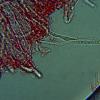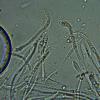
08-11-2025 00:29
 Francois Guay
Francois Guay
I found this species in Quebec, Canada, on herbace

04-11-2025 09:07
Hello.A suspected Hymenoscyphus sprouting on a thi

04-11-2025 12:43
 Edvin Johannesen
Edvin Johannesen
Hi! One more found on old Populus tremula log in O

03-11-2025 21:34
 Edvin Johannesen
Edvin Johannesen
These tiny (0.4-0.5 mm diam.), whitish, short-stip
Hamatocanthoscypha sps perhaps
Hardware Tony,
17-03-2024 15:50
 Found on last year's grass sps. on damp soil, I have truned to Hamatocanthoscypha as it appears this species has hooked hair ends and this species reacts as bright yellow granular content in KOH. However, none of the species under this genus seem to fit, especially the Apothecia concolourous colour and those growing on monocots etc. Apprecaite an indication of the genus please, species. With thanks
Found on last year's grass sps. on damp soil, I have truned to Hamatocanthoscypha as it appears this species has hooked hair ends and this species reacts as bright yellow granular content in KOH. However, none of the species under this genus seem to fit, especially the Apothecia concolourous colour and those growing on monocots etc. Apprecaite an indication of the genus please, species. With thanks
Kosonen Timo,
17-03-2024 17:48

Re : Hamatocanthoscypha sps perhaps
Not a Hamatocanthoscypha. I think it's all paraphyses. Maybe without actual hairs? Seek the end cells at the apo margin and continue down towards the stem, that's where the hairs are - that is , if there are any. Sometimes they are lost in a squash mount if they are tiny and in small numbers.
But, I cant answer your question, dont know the genus... Good documentation otherwise.
Timo
But, I cant answer your question, dont know the genus... Good documentation otherwise.
Timo
Kosonen Timo,
17-03-2024 17:49

Re : Hamatocanthoscypha sps perhaps
*towards the apo base - I tried to say....
T
T
Hardware Tony,
17-03-2024 22:04

Re : Hamatocanthoscypha sps perhaps
Hi Tima,
With thanks for your thoughts. Makes sense as why have hairs if they do not extend beyond the apo margin/asci. I will double check as you suggest. Otherwise I'll focus on genera with hooked paraphyses. Strange maybe that some change colour, some don't and are different widths, which is why I thought they were hairs. Tony
With thanks for your thoughts. Makes sense as why have hairs if they do not extend beyond the apo margin/asci. I will double check as you suggest. Otherwise I'll focus on genera with hooked paraphyses. Strange maybe that some change colour, some don't and are different widths, which is why I thought they were hairs. Tony
Hardware Tony,
18-03-2024 16:36

Re : Hamatocanthoscypha sps perhaps
Hi Timo,
Checked again and think you are right but with very variable paraphyses, 20% with uncinate tips, 50% slightly swollen curved, 25% straight, 5% thick Hockey stick end! Most two branched and with yellow VBs or resin, 2/3rd into thinner hyaline base. Spores seen a little easier but again variable now lasrger length 6.58 - 12.90 x 1.72 - 2.28 µm. Medullary excipulum easier in Congo Red showing sub-spherical and more prismatic at Ectal. Checked evrything I know and came up with Calycellina/Hymenoscyphus type maybe due to yellow/VBs but otherwise mystery. I might try and get this sequenced unless anyone has any other ideas.
With thanks Tony
Checked again and think you are right but with very variable paraphyses, 20% with uncinate tips, 50% slightly swollen curved, 25% straight, 5% thick Hockey stick end! Most two branched and with yellow VBs or resin, 2/3rd into thinner hyaline base. Spores seen a little easier but again variable now lasrger length 6.58 - 12.90 x 1.72 - 2.28 µm. Medullary excipulum easier in Congo Red showing sub-spherical and more prismatic at Ectal. Checked evrything I know and came up with Calycellina/Hymenoscyphus type maybe due to yellow/VBs but otherwise mystery. I might try and get this sequenced unless anyone has any other ideas.
With thanks Tony
Kosonen Timo,
19-03-2024 11:08

Re : Hamatocanthoscypha sps perhaps
The combo of ecology & morphology (especially the paraphyses) doesnt ring a bell to me. I have found remotely similar material from large-diam decayed tree trunks. I have no no name for those either. The content suggests Calycellina/Phialina - Pezizellaceae yes. But it appears this character is not restricted to that clade. Sequence are always helpful.
Timo
Timo


 Hamatocanthoscypha sps?
Hamatocanthoscypha sps?


